
|
Monastic Journey
Continued |
|||||
Stanley Roseman
The MONASTIC LIFE
The MONASTIC LIFE
HISTORIC REGIONS of MONASTICISM
in BAVARIA and SWABIA
in BAVARIA and SWABIA
© Stanley Roseman and Ronald Davis - All Rights Reserved
Visual imagery and website content may not be reproduced in any form whatsoever.
Visual imagery and website content may not be reproduced in any form whatsoever.
Brother Regenfried at Vespers, 1984
Archabbey of St. Ottilien, Germany
Chalks on paper, 50 x 35 cm
Collection Archabbey of St. Ottilien
Archabbey of St. Ottilien, Germany
Chalks on paper, 50 x 35 cm
Collection Archabbey of St. Ottilien
11. Brother Walafried,
the Bookbinder, 1982
Archabbey of Beuron, Germany
Chalks on paper, 50 x 35 cm
Private collection, London
the Bookbinder, 1982
Archabbey of Beuron, Germany
Chalks on paper, 50 x 35 cm
Private collection, London
''This is, as far as I know, the first time any artist of note has undertaken such a project.
Roseman's work has greatly impressed those of us in the monastic world
who have been fortunate enough to see it. His pictures are technically of the highest quality,
and he has succeeded in a remarkable way in conveying the spiritual dimension of his subjects.''
Roseman's work has greatly impressed those of us in the monastic world
who have been fortunate enough to see it. His pictures are technically of the highest quality,
and he has succeeded in a remarkable way in conveying the spiritual dimension of his subjects.''
- Dom Victor Dammertz, OSB
Archabbot of St. Ottilien (1975-1977)
Abbot Primate of the Order of St. Benedict (1977-1992)
Bishop of Augsburg (1993-2004)
Archabbot of St. Ottilien (1975-1977)
Abbot Primate of the Order of St. Benedict (1977-1992)
Bishop of Augsburg (1993-2004)
In the days that followed, Roseman created a series of superb drawings of Brother Walafried in his workshop as well as at the Divine Office in choir.
5. Two Benedictine Monks
at Compline, 1984
Archabbey of St. Ottilien, Germany
Chalks on paper, 50 x 35 cm
Vatican Museum, Vatican City
at Compline, 1984
Archabbey of St. Ottilien, Germany
Chalks on paper, 50 x 35 cm
Vatican Museum, Vatican City
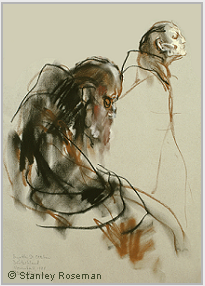
Father Damian, Missionary Monk, kneeling in Prayer, 1984, (fig. 6), is conserved in the Teyler Museum, the Netherlands.
Monastic Journey Continued
Page 3 - Historic Regions of Monasticism in Bavaria and Swabia
6. Travels to Sweden and Denmark
3. Historic Regions of Monasticism
in Bavaria and Swabia
in Bavaria and Swabia
Monastic Journey Continued
On the bottom of this page are links to the other pages.
2. Returning to the Netherlands
7. Convents in Piedmont
and Tuscany
and Tuscany
1. A Painting Studio
at the Abbey of La Trappe
at the Abbey of La Trappe
8. Monasteries in Old Castile
4. Returning to England
5. Sojourns in Belgium
Monasticism is strongly rooted in the religious and cultural traditions in Bavaria and Swabia and continues into the modern age, as at the Archabbey of St. Ottilien, represented at the top of the page by Roseman's drawing Brother Reginfried at Vespers, 1984, in the collection of the monastery. The impressive drawing depicting the Benedictine monk kneeling in prayer is beautifully rendered with fluent strokes and transparent passages of black and bistre chalks, black shading on the voluminous cowl, and accents of white chalk for the monk's beard.
In the first year of Stanley Roseman's work on the monastic life, the artist and his colleague Ronald Davis, with letters of invitation, traveled to Germany in October 1978. They sojourned at the Archabbey of St. Ottilien, located on the railway line between Augsburg and Garmisch; and at St. Bonifaz Abbey, in Munich. The monastic origins of numerous European towns and cities are exemplified by the city of Munich, which developed around a monastery in the Middle Ages and whose name in Old German - "Munichen'' - means "home of the monks.''
Archabbey of St. Ottilien, a Modern-Day Monastery Town
4. Brother Erwin at Vespers, 1982
Archabbey St. Ottillien, Germany
Chalks on paper, 50 x 35 cm
Prentenkabinet-Kunsthistorisch
Instituut der Rijksuniversiteit, Leiden
Archabbey St. Ottillien, Germany
Chalks on paper, 50 x 35 cm
Prentenkabinet-Kunsthistorisch
Instituut der Rijksuniversiteit, Leiden
The Institute of Art History of the University of Leiden acquired in 1985 the drawing Brother Erwin at Vespers by vote of the Institute's young art historians who, along with the Keeper of Drawings, selected five of Roseman's drawings from the monasteries. The Leiden Print Room houses an important collection of Master Drawings from the Dutch, Flemish, German, French, and Italian schools.
The Keeper of Drawings Dr. Janno van Tatenhove expressed his gratitude to Davis when he brought the suite of drawings to Leiden and said that Roseman's drawings are the first by an American artist acquired for the University Print Room. Dr. Van Tatenhove reiterates in his cordial letter to Roseman that "until now we had no American drawings at all."
3. The St. Ottilien Train Station.
The station stop at the Archabbey of St. Ottilien
is on the north-south railway line
between Augsburg and Garmisch, 1984.
The station stop at the Archabbey of St. Ottilien
is on the north-south railway line
between Augsburg and Garmisch, 1984.
The Teyler Museum houses a renowned collection of Master Drawings from the Italian Renaissance, including sheets by Michelangelo and Raphael, and from the seventeenth-century Dutch School, notably drawings by Rembrandt.
Father Damian, who had been in missionary work overseas, returned to St. Ottilien in his later years. Roseman composed the drawing with a strong diagonal that brings the viewer's attention to the monk's face finely rendered with transparent passages of black and brown shading and accents of white on his closely cropped beard. The monk's hands are held together in a reverential gesture as he kneels in prayer.
The Chief Curator Carel van Tuyll writes in a cordial letter of appreciation to Davis, who had introduced his colleague's work to the museum:
"The two splendid drawings arrived safely and have now joined their fellows.
Both 'Brother Caesarius in Choir' and the 'Missionary Monk, St. Ottilien' fully lived up to expectation
and we are proud that we are now able to show such a rounded and representative group of
Mr. Roseman's drawings in the Teyler Museum.''
Both 'Brother Caesarius in Choir' and the 'Missionary Monk, St. Ottilien' fully lived up to expectation
and we are proud that we are now able to show such a rounded and representative group of
Mr. Roseman's drawings in the Teyler Museum.''
- Carel van Tuyll, Chief Curator
Teylers Museum, Haarlem
Teylers Museum, Haarlem
St. Stephan Abbey, Augsburg
7. Father Subprior Joseph in Choir, 1982
St. Stephan Abbey, Augsburg
Chalks on paper, 50 x 35 cm
Private collection, Switzerland
St. Stephan Abbey, Augsburg
Chalks on paper, 50 x 35 cm
Private collection, Switzerland
9. Brother Sebastian serving
in the Refectory, 1982
St. Stephan Abbey, Augsburg
Chalks on paper, 50 x 35 cm
Mead Art Museum
Amherst College, Massachusetts
in the Refectory, 1982
St. Stephan Abbey, Augsburg
Chalks on paper, 50 x 35 cm
Mead Art Museum
Amherst College, Massachusetts
Abbot Odilo Lechner writes in a warm letter to Davis: "You and Stanley Roseman are very welcome when you are coming to Munich in October.'' The Abbot thoughtfully extended his invitation to the artist and his colleague to return to St. Bonifaz after their journey to monasteries in Austria, Hungary, and Poland and before they traveled south to Italy. Returning to Munich in late November and with the encouragement and gracious hospitality of Abbot Odilo, Roseman resumed his work at St. Bonifaz. (On the first year of Roseman's work, see "The Monastic Life,'' Page 3 - "On the Continent to Belgium, the Netherlands, and Germany.)
Roseman's work on the monastic life brought him and Davis a return to the Archabbey of St. Ottilien in 1982, with a warm welcome back from the Archabbot Notker Wolf.
"During the Merovingian and Carolingian periods, with the great expansion of monastic life throughout Europe, many monasteries developed into self-sufficient urban centers, or monastery towns, such as the Abbey of St. Gall, which gave rise to the city by that name in northeast Switzerland. The architectural plan of St. Gall, c.820, indicates the extensive monastic complex of abbey church, cemetery, and numerous conventual buildings for the monks; workshops, farmyards, gardens, and orchards; infirmary and doctor's house; school, guesthouse, kitchens, bakeries, breweries for the monastic community and for the guesthouse, as well as a hospice for pilgrims and the poor. A mill, granary, and lodgings for workmen, dairymen, stablemen, swineherds, and shepherds extended the district of the monastery town.[1]
"The Benedictine Archabbey of St. Ottilien, about 40 kilometers west of Munich, is a modern-day monastery town. Founded in 1884, St. Ottilien developed from a modest, mission settlement to the present, sprawling complex comprising the abbey church and buildings for the monastic community, some twenty workshops, farms for livestock and poultry, and many acres of land under cultivation.
"The monastery runs a boarding school, junior college, guest house, and retreat center. The printing company continues a centuries-old monastic tradition of book production, and a bookstore and boutique offer publications and products from St. Ottilien and other monasteries. A hotel and restaurant accommodate guests and pilgrims. An ethnological museum of African and Asian culture relates to the Congregation of St. Otillien's missionary activities in Africa, Asia, and South America.
"The monastery post office, which adjoins the entrance building, issues its own postmark. And the St. Ottilien train station, on the north-south railway line between Augsburg and Garmisch, reaffirms the identity of a modern-day monastery town.''
2. The Archabbey of St. Ottilien, Bavaria
In a text to accompany his paintings and drawings on the monastic life, Roseman dedicates a chapter to the monastic origins of European towns and cities. The artist refers to that history in regards to St. Ottilien, a modern-day monastery town. The following are excerpts from the artist's text:
Monks and Books
Archabbot Notker Wolf invited Roseman and Davis to return to St. Ottilien in 1984 for the artist to draw on the occasion of the 100th anniversary of the founding of the monastery.
The Archabbot of St. Ottilien, Notker Wolf, an amiable, hospitable man, expressed his enthusiasm for Roseman's work, which includes drawings from the artist's sojourn at the abbey in the summer of 1982 and again that autumn, when the artist was commissioned to paint a portrait of the Archabbot. In correspondence with Roseman, Archabbot Notker writes: "I am thinking very often of you, and I see you still painting here in my room. It was a wonderful human experience. I enjoy the portrait always when I enter the room. . . . With heartfelt greetings, I remain Notker.''
Roseman's sojourns in monasteries brought him in contact with monks and nuns who were authors, translators, editors, bookbinders, and librarians, many of whom were subjects for the artist's work.
At St. Ottilien, Roseman was befriended by Brother Erwin, the Assistant Librarian, seen in the drawing below, (fig. 4). The monk appreciated the artist's love of books. In making the library available to the artist, Brother Erwin thoughtfully recommended books (in English) to further Roseman's studies on monastic life.
Brother Erwin at Vespers, 1982, depicts the ascetic, Benedictine monk seated in choir. Brother Erwin, a monk of advancing years, wore dark glasses as his eyes were sensitive to light and a skullcap, or zucchetto, a preference of some monks of the four monastic Orders. Roseman draws with fluent strokes of black and bistre chalks complemented by chiaroscuro modeling with white highlights on the monk's face, bushy moustache, and long, tapering beard. In this superb drawing Brother Erwin sits with hands folded on his lap and attentively listens to a reading from the Scriptures.
The 100th Anniversary of the Founding of St. Ottilien
From a text to accompany his work in monasteries, Roseman writes:
"In late autumn of 1982 Ronald and I traveled to Augsburg, the birthplace of Hans Holbein, the Elder, in c.1465, and the Younger, in 1497. Dürer was in Augsburg for the Imperial Diet of 1518 to draw portraits of Emperor Maximilian I and other prominent personages, including the industrialist, banker, and philanthropist Hans Jakob Fugger.[2] Augsburg was an ancient Roman trading center, and today the City's Römisches Museum houses an important collection of Roman antiquities.
"Monastic life in Augsburg dates back to the early eleventh century with the founding of the Benedictine Abbey of Sts. Ulrich and Afra. The Secularization of 1802 brought about the suppression of religious communities in Germany. In 1834-35, under the royal patronage of King Ludwig I, the former convent of St. Stephan in Augsburg was appropriated for a community of Benedictine monks to continue the observance of monastic spirituality and to resume a centuries-old Benedictine tradition of teaching and the administration of a school.
"With a cordial invitation from Abbot Albert Brettner and his gracious hospitality and encouragement of my work, Ronald and I were warmly received at St. Stephan Abbey. We were given comfortably furnished rooms, invited to take our meals with the Community in the refectory, and joined the monks for the round of communal prayer in choir.''
Father Subprior Joseph in Choir, (fig. 7), drawn on a December afternoon, depicts the elderly Benedictine monk in his voluminous cowl. The monk's hood lowered to his shoulders is defined with broad strokes of black chalk. With fine lines and transparent passages of black and brown shading heightened with white, the artist rendered the face of the monk, his head inclined as he prays.
8. A Benedictine Monk in Choir, 1982
St. Stephan Abbey, Augsburg
Chalks on paper, 50 x 35 cm
Private collection, Geneva
St. Stephan Abbey, Augsburg
Chalks on paper, 50 x 35 cm
Private collection, Geneva
Drawing - the Foundation of the Visual Arts
Drawings account for a great portion of Roseman's oeuvre. Roseman's dedication to drawing is in keeping with the beliefs of Giorgio Vasari, the celebrated sixteenth-century Florentine architect, painter, and author for whom drawing (disegno) is the foundation of the visual arts.[3]
Although drawings have traditionally served as studies or drafts in preparation for compositions to be realized in another medium, drawings can be autonomous works of art. Confirmation of this is the artist's signature on a drawing, as well as a date or an inscription. Roseman signs, inscribes, and dates his drawings, as did Dürer in an early precedent in Western art. Dürer's drawings signed and dated with the artist's monogram often carry additional information identifying the work. The Dürer scholar Peter Strieder writes in describing certain drawings by the artist: "Signature and inscription mark the drawing as an autonomous work, not intended to be converted into another medium.''[4]
From Roseman's work at Augsburg is A Benedictine Monk in Choir, 1982, (fig. 8, below), a striking asymmetrical composition with the placement of the figure counterbalanced by a bold use of pictorial space.
In Roseman's work on the monastic life, the artist drew monks in choir, the library, the scriptorium, the calefactory, in their cells, at their workplaces, in the kitchen, and in the refectory. Roseman writes in his text:
"The Rule of St. Benedict prescribes regulations for meals in the chapters on the weekly servers in the kitchen, the weekly reader, the measure of food, the measure of drink, and the hours the meals should be taken (Chapters 35, 38, 39, 40, and 41, respectively). St. Benedict, writing in sixth-century Italy, allots to each monk daily a pound of bread and a hemina of wine, approximately half a pint or a little more than a quarter of a liter.
"Following the monastic precept ora et labora, prayer and work, monks have for centuries cultivated vineyards and produced wine in regions conducive to viticulture. Similarly, brewing beer is a centuries-old work of northern European monasteries. For example, facilities for brewing beer are indicated on the ninth-century architectural Plan of St. Gall. Today, beer production is a source of income for a number of monasteries in Germany, Austria, Belgium, and the Netherlands and also provides monastic communities with a beverage to accompany meals.''
In the Refectory
From Roseman's sojourn in Augsburg at St Stephan Abbey is the present work Brother Sebastian serving in the Refectory, 1982, (fig. 9), in the collection of the Mead Art Museum, Amherst College, Amherst, Massachusetts.
''The drawings, for the most part done in combinations of black, white, and sepia chalk on beige or gray paper, are impressive. Roseman has captured the personalities of many individual monks while often managing to depict their lifestyles as well. . . . The artist's gray, brown, dark and light tones vary as subtly and surely as the monks who live out their discipline of prayer and work and meals in common.''
- The Boston Globe
The Boston Globe published in 1979 on its page "US and World" a news article entitled "Monks' life through art," the first reportage of Roseman's work on the monastic life which was to receive praise in newspapers and journals worldwide. In 1981, The Boston Globe published a cover story on the artist in its Sunday magazine.
10. The Archabbey of Beuron, Swabia
The Mead Art Museum acquired the drawing in 1986. The Amherst College Museum's collection is noted for works on paper by American artists. Brother Sebastian serving in the Refectory entered the collection with Roseman's drawing Portrait of a Carthusian Monk, 1984, Parkminster, England, reproduced on the website page "Carthusians."
"I am very pleased with the drawings,'' writes the Mead Art Museum's Director Frank Trapp in acknowledging "this fine gift to the collection of Amherst College.''
The Mead Art Museum's drawing Brother Sebastian serving in the Refectory is complemented by other Roseman drawings of monks taking their meals in the refectory, serving the community, cooking in the kitchen, and washing up after meals.
The Musée des Beaux-Arts, Bordeaux, conserves the drawings A Trappist Monk at Dinner, 1978, St. Sixtus Abbey, Belgium; and Brother Andrew in the Refectory, 1980, Farnborough Abbey, England. (See "Monastic Life'' - Page 3 "On the Continent to Belgium, the Netherlands, and Germany'' and "Monastic Journey Continued'' - Page 4 "Returning to England'')
The Archabbey of Beuron is situated on a rise above the Danube in a forested valley in Swabia, a land once populated with monasteries since the Middle Ages, when the Duchy of Swabia included present-day south-western Germany as well as the Alsace and eastern Switzerland. In the mid-nineteenth century, with the revival of monasticism in Germany, the property at Beuron that had housed a community of Augustinian Canons from 1077 to the Secularization in 1802 was established in 1862 as a Benedictine monastery.[5]
Archabbey of Beuron, Swabia
With a cordial invitation, Roseman and Davis sojourned at Beuron in December 1982. Roseman recounts: "Archabbot Hieronymous Nitz graciously welcomed Ronald and me and expressed his encouragement for my work on the monastic life.
"On the afternoon of our arrival the Abbot thoughtfully gave us an extended tour of the monastery. . . . Ronald and I were enthralled when the Abbot brought us into the famous library and showed us a number of incunabula and rare volumes, including a Biblia Sacra Polyglotta, a Bible from 1657 written in Hebrew, Greek, Chaldean, Syriac, Latin (Vulgate), Aramaic, Persian, and Ethiopic.
The Director General of the Vatican Museums, the distinguished Professor Carlo Pietrangeli, acquired in 1987 four Roseman drawings on the monastic life from the artist's sojourn at St. Ottilien in the monastery's centenary year. The acquisition includes Two Benedictine Monks at Compline, (fig. 5). The Archabbot thoughtfully donated the suite of drawings to the Vatican Museums.
Two Benedictine Monks at Compline, with its striking mise-en-page, combines linear description with a painterly use of the chalks on gray paper. The monk in his middle years stands in choir, his head uplifted and his concentration intense; the elderly, bearded brother in the foreground sits with body inclined and head lowered as he prays. In this compelling drawing, Roseman has depicted two men of different ages, each absorbed in prayer.
The Musée des Beaux-Arts, Rouen, acquired Father Gregory at Tea, 1980, St. Augustine's Abbey, England; and the Institute of Art History, Leiden University, mentioned above, conserves the drawing Brother Caesarius at Breakfast, 1982, Lutheran Benedictine Abbey of Östanbäcks, Sweden. (See "From the Artist's Memoirs" and "Monastic Journey Continued'' - Page 6 "Travels to Sweden and Denmark.'')
The distinguished collector of American drawings, John Davis Hatch, Co-founder of Master Drawings Association, acquired three Roseman drawings on the monastic life, including Frère Christian in the Kitchen, 1979, Abbey of Fleury, France, and acknowledges in letter, "they are great additions to my drawing collection.'' (See "Ora et Labora, Prayer and Work.'')
"Taking us through the cloister, the Abbot said he would like to introduce us to Brother Walafried, the bookbinder. We stopped by a door to a workshop, and the Abbot knocked on the door and brought us inside.
"Brother Walafried turned from his worktable. The ascetic, Benedictine monk had a full, graying beard and wore a black skullcap. He greeted us warmly and offered us a friendly regard.
"At the Abbot's suggestion, Brother Walafried led us into an adjoining, small room where a cabinet was filled with examples of his work. After showing us an assortment of tools for gold stamping, he kindly took down from the shelves a number of volumes with book covers he had designed in cloth and leather - beautiful books he had bound with consummate craftsmanship.''
Roseman's love of books and his appreciation for Brother Walafried's skillful craftsmanship and the monk's high regard for Roseman's draughtsmanship established a rapport between the artist and the bookbinder. The deeply felt portrait Brother Walafried, the Bookbinder, (fig. 11), is exemplary of Roseman's masterly use of the chalk medium, with fine chiaroscuro modeling, to express both the outward appearance and the inner being of the monk.
1. Kenneth John Conant, Carolingian and Romanesque Architecture 800-1200, (Harmondsworth: Penguin Books, 1973), pp. 20-23.
2. Jane Campbell Hutchison, Albrecht Dürer, a Biography, (Princeton: Princeton University Press, 1990), pp. 84, 119.
3. Giorgio Vasari, Vasari on Technique, (New York: Dover, 1960), p. 205.
4. Peter Strieder, Albrecht Dürer-Paintings, Prints, Drawings, (New York: Abaris Books, 1982), p. 248.
5. P. Ursmar Engelmann, OSB, Beuron, (Beuron: Beuroner Kunstverlag, 1982), p. 20, 21.
2. Jane Campbell Hutchison, Albrecht Dürer, a Biography, (Princeton: Princeton University Press, 1990), pp. 84, 119.
3. Giorgio Vasari, Vasari on Technique, (New York: Dover, 1960), p. 205.
4. Peter Strieder, Albrecht Dürer-Paintings, Prints, Drawings, (New York: Abaris Books, 1982), p. 248.
5. P. Ursmar Engelmann, OSB, Beuron, (Beuron: Beuroner Kunstverlag, 1982), p. 20, 21.
The museum acquired in 1986 the drawing of Father Damian and Roseman's drawing of Brother Caesarius from Östanbäcks Kloster, a Lutheran Benedictine Abbey in Sweden. (See "Monastic Journey Continued" - Page 6 "Travels to Sweden and Denmark.") The Teyler Museum had previously acquired Roseman's drawings from monasteries in England, Ireland, and France.
The monk, his hands covered by his scapular, leans over the railing of the choir stall. The railing divides the composition in two rectangular areas complemented by curvilinear strokes and tonal passages of the chalks that define the seated figure. Roseman finely renders the monk's head and face with white highlights and warm shading in this engaging drawing of a monk in meditation and prayer.
This fine drawing depicts the bespectacled, Benedictine monk carrying a tray with glasses of beer to serve the community. Roseman conveys a look of concentration on Brother Sebastian's face seen in profile and rendered in a combination of chalks. Calligraphic strokes and passages of black, white, and brown tones on gray paper describe the monk's habit and apron tied at the back. The drawing of Brother Sebastian serving in the refectory elicits from the viewer a pleasurable anticipation of enjoying a refreshing glass of beer.
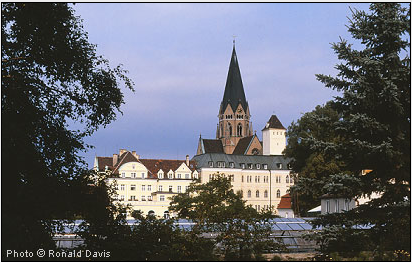
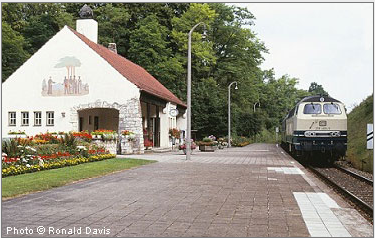
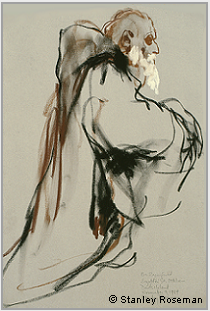
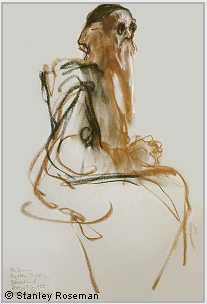
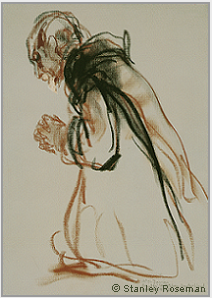
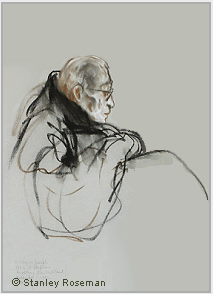
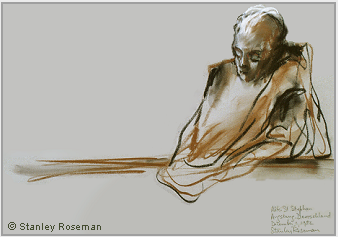
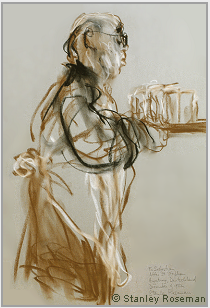
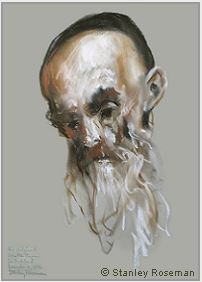
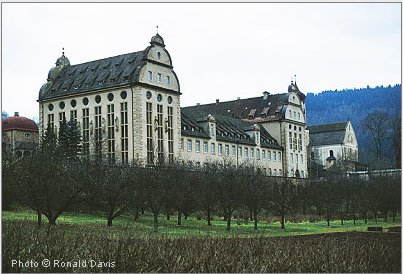
- from Psalm 4, sung at Compline
"I will lay me down in peace and sleep:
for thou, Lord, only makest me dwell in safety.''
for thou, Lord, only makest me dwell in safety.''
The Psalms of Compline, the last of the daytime Offices, bless the Lord and ask God for protection in the dark.
6. Father Damian, Missionary Monk, kneeling in Prayer, 1984
Archabbey St. Ottilien, Germany
Chalks on paper, 50 x 35 cm
Teylers Museum, Haarlem
Archabbey St. Ottilien, Germany
Chalks on paper, 50 x 35 cm
Teylers Museum, Haarlem
''The pictures - splendid and telling all at once - form the stimulating vanguard
towards so original and deep a study of the monastic life.''
towards so original and deep a study of the monastic life.''
The respected art journal ARA arte religioso actual, Madrid, states in its laudatory reportage
''Stanley Roseman y la Vida Monastica"
''Stanley Roseman y la Vida Monastica"